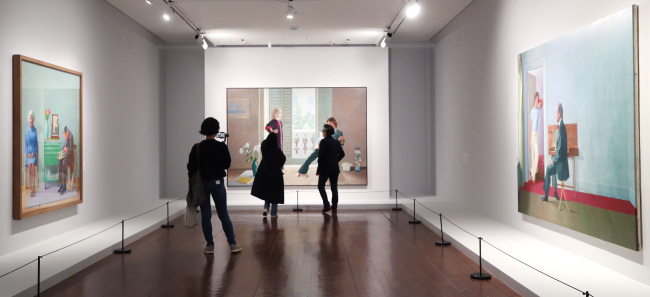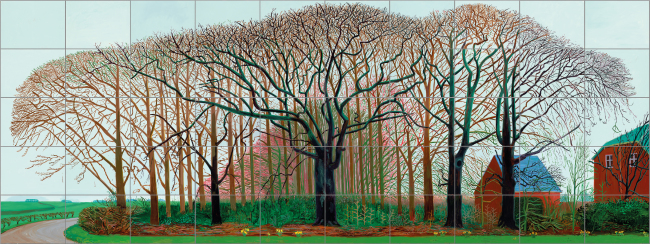The largest-ever David Hockney exhibition in South Korea is underway at the Seoul Museum of Art, featuring some of the artist’s iconic paintings such as “The Bigger Splash” (1967) and “A Bigger Grand Canyon” (1998) -- as well as “In the Studio, December 2017,” which is being shown to the general public for the first time.
 |
David Hockney’s double portraits are on exhibit at the Seoul Museum of Art on Thursday. (Yonhap) |
Born in 1937, Hockney is the world’s most famous, beloved and expensive living artist.
The English artist is known for his experiments with photography and new technology throughout his prolific career, and the works on view at SeMA attest to his range.
The majority of the 133 works on display here come from Tate Britain’s collection, with a number of pieces on loan from eight other institutions, including the Royal Academy of Arts and the Museum of Contemporary Art Tokyo.
“Third Love Painting” and “Tea Painting in an Illusionistic Style,” on display in the first part of the exhibition, show Hockney’s departure from conventional painting forms as well as his early efforts to develop his own painting language.
Tate Britain’s collection, shown at the SeMA, “demonstrates how Hockney’s extensive travel and periods living abroad have affected his methods and subjects,” according to Helen Little, the curator of the SeMA show, who also curated a Tate retrospective of the artist in 2017.
For example, “A Rake’s Progress” -- a series of 16 etchings, which he created after his first trip to America in 1961 -- references his travels.
“The First Marriage (A Marriage of Styles I),” which depicts his friend Jeff Goodman standing in profile next to an ancient Egyptian sculpture, was created following Hockney’s visit to the Pergamon Museum in Berlin with Goodman.
“Interested in the idea of a ‘marriage of styles’ between these two people -- ancient and modern, real and unreal -- Hockney presents each of them naturalistically and schematized,” Little said.
“A Bigger Splash” is the highlight of the section that follows, featuring Hockney’s early paintings and prints made in Los Angeles.
The swimming pools for which Hockney is perhaps best known form part of a broader repertoire of subjects that attracted Hockney when he moved to Los Angeles, according to Little. “
We must remember that -- during the 1950s and 1960s -- for a young English artist to move to California, this sort of ‘Technicolor’ experience would have been quite overwhelming,” Little said.
“Not only that, Hockney was drawn to LA because of the very hedonistic lifestyle he had consumed through magazines and newspapers. He was also very interested more formally in actually depicting this very alien city -- its modernity, its particular architecture and its exotic lifestyle. The pool paintings really developed after this fascination with the glamour and sexiness of this new culture,” she said.
A body of work created in homage to Picasso and those created after Hockney discovered Chinese scroll painting, which he described as having a vastly superior way of dealing with space and time, are on show on the museum’s third floor, along with the “Moving Focus” series.
“In a group of panoramic interiors and landscapes including three intensely colored lithographs of ‘Hotel Acatlan,’ multiple viewpoints and long, narrow compositions give the impression that the viewer is traveling through the work,” Little said.
 |
"Bigger Trees Near Warter Or/Ou Peinture Sur Le Motif Pour Le Nouvel Age Post-Photographique” (2007) by David Hockney (Tate) |
For the large-scale “Bigger Trees Near Water” (2007) and “A Bigger Grand Canyon” (1998) on display in the last section of the exhibition, Hockney employed computer technology, photographing each panel -- 60 panels for “A Bigger Grand Canyon” -- and tracking the development of the overall image, Little explained.
“In the Studio, December 2017,” a large-scale photographic drawing made by digitally stitching some 3,000 photographs, concludes the show.
While a wide range of his works are being shown at the exhibition, some of his important works are noticeably absent compared with the 2017 retrospective at Tate Britain.
Addressing the lack of photographic works at SeMA, Little explained that they are not in any public collections and the artist rarely loans them out.
Art historian and critic Marco Livingstone also addressed the issue during a lecture held Friday at SeMA.
“His works became extremely expensive. Even a major museum like Tate does not have enough funds to buy them, so they rely on the generosity of the artist to donate them,” he said.
Indeed, Hockney’s “Portrait of an Artist (Pool with Two Figures)” (1972) was sold at Christie’s last year for $80 million at the hammer, or $90.3 million with fees.
The exhibition runs through Aug. 4.
By Shim Woo-hyun (
ws@heraldcorp.com)









![[Today’s K-pop] Blackpink’s Jennie, Lisa invited to Coachella as solo acts](http://res.heraldm.com/phpwas/restmb_idxmake.php?idx=644&simg=/content/image/2024/11/21/20241121050099_0.jpg)